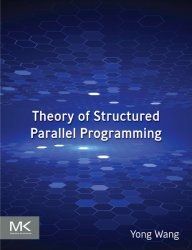 Название: Theory of Structured Parallel Programming
Название: Theory of Structured Parallel ProgrammingАвтор: Yong Wang
Издательство: Morgan Kaufmann/Elsevier
Год: 2024
Страниц: 200
Язык: английский
Формат: epub
Размер: 10.1 MB
Theory of Structured Parallel Programming is a comprehensive guide to structured parallel programming corresponding to traditional structured sequential programming. The book provides readers with comprehensive coverage of theoretical foundations of structured parallel programming, including analyses of parallelism and concurrency, truly concurrent process algebras, building block-based structured parallel programming, modelling and verification of parallel programming language, modelling and verification of parallel programming patterns, as well as modeling and verification of distributed systems.
There have been always two ways to approach parallel computing: one is the structured way, and the other is the graph-based (true concurrent) way. The structured way is often based on the interleaving semantics, such as process algebra CCS. Since the parallelism in interleaving semantics is not a fundamental computational pattern (the parallel operator can be replaced by alternative composition and sequential composition), the parallel operator often does not occur as an explicit operator, such as in the mainstream programming languages C, C++, Java, et al.
The graph-based way is also called true concurrency. There also have been some ways to structure the graph, but these work only considered the causal relation in the graph, and neglected the confliction and even the communication. And there are also industrial efforts to adopt the graph-based way, such as the workflow description language WSFL. The later workflow description language BPEL adopts both the structured way and the graph-based way. Why does BPEL not adopt the structured way only? It is because that the expressive power of the structured way is limited. Then why does BPEL not adopt the graph-based way only? It is just because that the graph could not be structured at that time and the structured way is the basis on implementing a compiler.
Now, it is the time to do some work on structured parallel programming under the background of programming language and parallel software engineering. On one side, traditional structured programming got great successes in sequential computation; on the other side, current structured parallel programming focused on parallel patterns (also known as parallel skeletons, templates, archetypes), with comparison to structured sequential programming, the corresponding structured parallel programming with solid foundation still is missing.
Introduces algebraic properties and laws for structured parallel programming, one of the foundational concepts of Computer Science
Discusses modeling and verification of parallel programming language, parallel programming patterns, and distributed systems
Demonstrates parallel programming language with its operational semantics, denotational semantics, axiomatic semantics, and their relations
Скачать Theory of Structured Parallel Programming